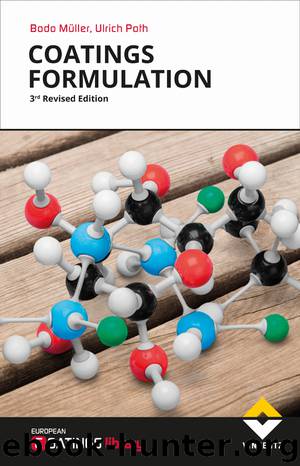Coatings Formulation by Bodo Müller

Author:Bodo Müller
Language: eng
Format: epub
Publisher: Vincentz Network
Published: 2017-03-26T16:00:00+00:00
Figure II-2.17: Principle reactions of blocked isocyanates
Figure II-2.18: Effective stoving temperatures of polyisocyanates blocked with different blocking agents with hydroxyl polyesters
Although methyl ethyl ketoxime is now defined as toxic, its blocked polyisocyanates are still standard products for stoving enamels (primer surfacers, topcoats). Blocked polyisocyanates with 3,5-dimethyl pyrazole are more reactive and offer better yellowing resistance. Although the products are relatively expensive, they are used for high-quality topcoats and clearcoats featuring outstanding weatherability. Blocked polyisocyanates with ethyl acetoacetate and diethyl malonate react at significantly lower temperatures than those with other blocking agents. The reaction with hydroxyl groups takes the form of a trans-esterification, the cleavage product being ethanol[16]. The reaction is supported by the directing influence of the ß-diketo groups. In the case of diethyl malonate, this reaction is much more pronounced. GC analysis reveals little cleavage of ß-diketo blocking agents until much higher temperatures are reached. The reaction of ß-diketo blocking agents is presented in Figure II-2.19.
It is also possible to use cyclopentanone-2-carboxylic ester as a blocking agent; it also contains ß-diketo structures. At high temperatures, reaction with hydroxyl groups leads to ring opening and possibly crosslinked structures, without cleavage of any low-molecular products[31]. Since the effective stoving temperatures of paints containing polyisocyanates blocked with 3,5-dimethyl pyrazole and the ß-diketo blocking agents are relatively low, the products meet the application requirements of automotive OEM (20 to 30 min at 130 to 145 °C). As the films offer excellent weather resistant, the products are suitable for topcoats and clearcoats. Ethyl acetoacetate causes some yellowing. Blocking with diethyl malonate requires special measures to improve the solubility of the blocked polyisocyanates with it.
If the stoving temperatures are higher than 200 °C, secondary and tertiary alcohols and glycol monoethers may also be used as blocking agents.
Resins containing free amino groups react much faster with blocked isocyanates than those containing hydroxyl groups. There are two -component formulations with partners, which are of very low viscosity, and reactive at room temperature (see Part IV: Solvent-free paints). Like free polyisocyanates, blocked aromatic polyisocyanates also react much faster than blocked aliphatic or cycloaliphatic polyisocyanates.
The production of blocked polyisocyanates is based on the same polyisocyanate used as crosslinkers in two-component paints containing resins bearing hydroxyl groups. These include urethane oligomers, such as the product of the reaction between trimethylol propane and three molecules of toluene diisocyanate (TDI); the isocyanurate trimers of TDI, hexamethylene diisocyanate (HDI) and isophorone diisocyanate (IPDI); and finally the biuret of HDI.
Download
This site does not store any files on its server. We only index and link to content provided by other sites. Please contact the content providers to delete copyright contents if any and email us, we'll remove relevant links or contents immediately.
500 AP Chemistry Questions to Know by Test Day(1212)
MCAT General Chemistry Review 2019-2020 by Kaplan Test Prep(1147)
The Great Mental Models Volume 2 by Shane Parrish(1099)
500 AP Chemistry Questions to Know by Test Day by Mina Lebitz(1059)
5 Steps to a 5 by John T. Moore(990)
Rules for Writers by Diana Hacker & Nancy Sommers(875)
MCAT General Chemistry Review by Princeton Review(845)
Cracking the SAT Chemistry Subject Test, 1 by Princeton Review(823)
Ingredients by George Zaidan(762)
The MCAT Chemistry Book by Aryangat Ajikumar(726)
A Rulebook for Arguments by Weston Anthony;(699)
MCAT Organic Chemistry Review by Princeton Review(679)
MCAT General Chemistry Review 2020-2021 by Kaplan Test Prep(607)
Kaplan MCAT General Chemistry Review: Created for MCAT 2015 (Kaplan Test Prep) by Kaplan(587)
5 Steps to a 5 by Mina Lebitz(585)
The Elements We Live By: How Iron Helps Us Breathe, Potassium Lets Us See, and Other Surprising Superpowers of the Periodic Table by Anja Røyne(560)
5 Steps to a 5: AP Chemistry 2017 by Moore John T. & Langley Richard H(550)
5 Steps to a 5 AP Chemistry 2014-2015 by Richard H. Langley & John T. Moore(529)
5 Steps to a 5 500 AP Biology Questions to Know by Test Day by Mina Lebitz(484)
